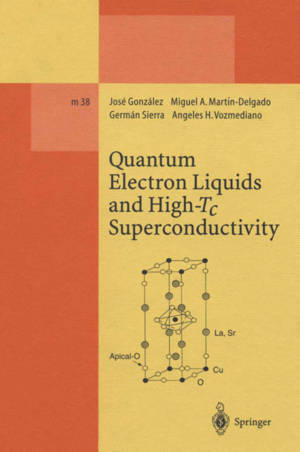
- Retrait gratuit dans votre magasin Club
- 7.000.000 titres dans notre catalogue
- Payer en toute sécurité
- Toujours un magasin près de chez vous
- Retrait gratuit dans votre magasin Club
- 7.000.0000 titres dans notre catalogue
- Payer en toute sécurité
- Toujours un magasin près de chez vous
Quantum Electron Liquids and High-Tc Superconductivity
Jose Gonzalez, Miguel A Martin-Delgado, German Sierra, Angeles H Vozmediano
52,95 €
+ 105 points
Description
This book originated from a course given at the Univcrsidad Aut6noma of Madrid in the Spring of 1994 and in the Universidad Complutense of Madrid in 1995. The goal of these courses is to give the non-specialist an introduction to some old and new ideas in the field of strongly correlated systems, in particular the problems posed by the high-1 superconducting materials. As theoretical physicists, our starting viewpoint to address the problem of strongly correlat- ed ferlnion systems and related issues of modern condensed matter physics -is the renormalization group approach applied both to quantU111 field theory and statistical physics. In recent years this has become not only a powerful tool for retrieving the essential physics of interacting systems but also a link between theoretical physics and modern condensed matter physics. Furthermore, once we have this common background for dealing with apparently different prob- lems, we discuss more specific topics and even phenomenological aspects of the field. In doing so we have tried to make the exposition clear and simple, with- out entering into technical details but focusing ill the fundamental physics of the phenomena under study. Therefore, ve expect that our experience ll1ay have some value to other people entering this fascinating field. We have divided these notes into three parts and each part into chapters, which correspond roughly to one or two lectures. Part I, Chaps. 1-2 (A. H. V.
Spécifications
Parties prenantes
- Auteur(s) :
- Editeur:
Contenu
- Nombre de pages :
- 302
- Langue:
- Anglais
- Collection :
- Tome:
- n° 38
Caractéristiques
- EAN:
- 9783662140123
- Date de parution :
- 18-04-14
- Format:
- Livre broché
- Format numérique:
- Trade paperback (VS)
- Dimensions :
- 156 mm x 234 mm
- Poids :
- 444 g

Les avis
Nous publions uniquement les avis qui respectent les conditions requises. Consultez nos conditions pour les avis.






